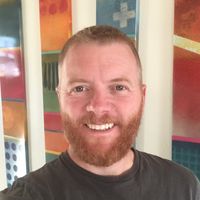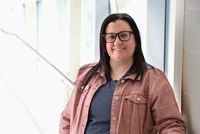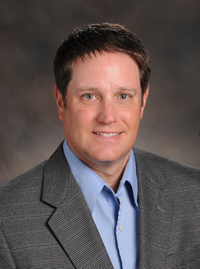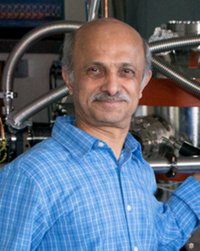The Visiting Committee consists of departmental alumni who meet with faculty, staff,
and students annually to provide advice on strategic initiatives and future
directions for growth. We are grateful to the members of this committee for their contributions. Learn more about the committee below.

Dr. Sean M. Finnegan received his Ph.D. in physics from West Virginia University in 2008, where his research (largely theoretical) focused on plasma waves in the ionosphere. Upon graduation, he joined LANL as a post-doc in XCP-6 (Plasma Theory and Applications) working on simulations of laser-plasma-interactions, and contributing to the design of capsule implosions for the study of material mixing in burning plasmas. In 2011, he joined the Department of Energy’s Office of Science, Fusion Energy Sciences (FES) program office, as the program manager for the high-energy-density plasmas portfolio, later becoming the management team-lead for the broader Discovery Plasma Science portfolio within FES. While in the Office of Science, he oversaw funding activities executed jointly between FES and the National Science Foundation as well as with the National Nuclear Security Administration (NNSA), served on the Office of Science User Facilities Working Group, and organized an Intergovernmental Working Group for High-Energy Density (HED) Science. He later joined the NNSA management staff in the Office of Research, Development, Test, and Engineering overseeing the ICF-Ignition, HED-Facilities, and HED Academic Awards (including the Laboratory for Laser Energetics at the University of Rochester) portions of the Weapons Activities portfolio. Additionally, he served as the program lead for NNSA on the Warhead Options Working Group as part the 2018 Nuclear Posture Review implementation activities. In 2019 he returned to technical work, rejoining the staff at LANL in XTD-IDA (Integrated Design and Assessment) where his research has focused on thermonuclear systems, radiation transport in high-energy-density plasma, and novel algorithms for kinetic plasma modeling. He currently serves on the Scientific Advisory Board for Laser-Net US, the HED Council for the NNSA HED Facilities, is the LANL lead for the HED physics topical area of the Joint Center for Resilient National Security and serves as the program manager for the Secondary Assessment Technologies program.

Dr. Rachel Henderson attended graduate school at West Virginia University from 2012 to 2018 where she received her Master’s degree and PhD in physics. Prior to WVU, she earned her Bachelor’s degree in physics from Slippery Rock University in Pennsylvania. During her time at WVU, her dissertation work was supervised by John Stewart where she focused on the gender inclusivity of the rather historic yet commonly used physics assessments. In 2018, she moved to Michigan where she did her postdoctoral work in collaboration with Marcos “Danny” Caballero in the Physics Education Research Lab at Michigan State University (MSU). There, she focused on developing formal structures to support the newly transformed physics laboratories while developing assessment tools and practices for understanding student learning within these courses. In 2020, Rachel was hired as an Assistant Professor at MSU where she is currently jointly appointed in the Department of Physics and Astronomy and the CREATE for STEM Institute. Generally, Rachel is a quantitative methods researcher who focuses on developing and implementing inclusive and equitable educational instrumentation that can be used to improve the learning and retention for students seeking Bachelor’s degrees in STEM. She has served as a member-at-large for the APS Topical Group on Data Science and the APS Topical Group on Physics Education Research and is currently serving as the chair of the American Association of Physics Teacher Physics Education Research Leadership and Organizing Council (PERLOC) as well as the secretary for the Eastern Great Lakes Section of APS.

Dr. John Lannon received B.S., and Ph. D. degrees in Physics from WVU (1991, 1996). and is currently is the General Manager of Micross Advanced Interconnect Technology. Since 2002, he has worked on the fabrication and improvement of resistive IR emitter devices (a MEMS-like device) for Infrared Scene Projectors. Beginning in 2005, he assisted with the development of high density interconnects (sub-20 µm pitch) for die stacking and detector hybridization and more recently contributed to the development of wafer-level vacuum packaging (WLVP) for MEMS devices. As part of Micross, he focuses on the development and implementation of 3D integration and advanced packaging technologies for government and commercial applications, as well as the development of novel 3D microstructures.

Dr. Jagadeesh S. Moodera received his Ph.D. in Physics from Indian Institute of Technology (Madras). He joined MIT in 1981 as a research staff at the Francis Bitter National Magnet Laboratory (FBML), where he leads the “Thin Film Magnetism, Superconductivity and Nanospintronics” group. He has worked in several areas of fundamental and applied physics including nanospintronics, spin polarized transport and tunneling, thin film magnetism, superconductivity and topological insulators. He was elected Fellow of the American Physical Society in 2000 and awarded the Oliver E. Buckley Condensed Matter Prize from the American Physical Society in 2009. Learn more about Dr. Moodera here.

Dr. Randy Tompkins is currently the Chief of the Sensor Experimentation branch at the Combat Capabilities Development Command (DEVCOM) Army Research Laboratory (ARL) in Adelphi, MD. Previously, Dr. Tompkins was the Team Leader of the Compact Power Team in the Energy Conversion branch ARL. His research interests include sensors, legged robotics, energy conversion materials and devices, semiconductor material growth and characterization, as well as device fabrication and characterization of wide and ultra-wide bandgap semiconductors for high power electronic, optoelectronic and betavoltaic applications. He has authored/co-authored over 30 papers on both III-Nitride and II-VI semiconductors in his career.

Mr. Michael Howell received his B.S. In Physics from West Virginia University in 2021. Mr. Howell is a certified Physics and Mathematics teacher at Sherman High School in Seth, WV. He has experience teaching at the West Virginia Governor's STEM Institute, and is a recipient of the PhysTEC Local Teacher of the Year Award. Mr. Howell specializes in rural STEM education and has participated in physics outreach programs in Boone, Cabell, Kanawha, and Monongalia counties. These outreach programs include the topics of engineering design, cybersecurity, and astronomy with Marshall University and West Virginia State University. He collaborated with secondary and post-secondary physics teachers around West Virginia, and the NASA West Virginia Space Grant Consortium to create accessible, inquiry-based lesson plans modeling real-life NASA problem solving. His research experience involves molecular beam epitaxy of boron-based quantum materials, and physics education research at West Virginia University. Mr. Howell also instructs the award-winning Sherman High School marching band drumline.